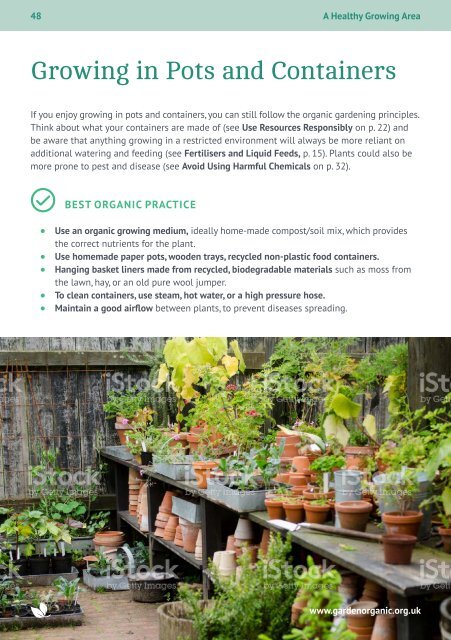Garden Organic Booklet - Final Draft 01
Create successful ePaper yourself
Turn your PDF publications into a flip-book with our unique Google optimized e-Paper software.
48 A Healthy Growing Area<br />
A Healthy Growing Area<br />
Growing in Pots and Containers<br />
If you enjoy growing in pots and containers, you can still follow the organic gardening principles.<br />
Think about what your containers are made of (see Use Resources Responsibly on p. 22) and<br />
be aware that anything growing in a restricted environment will always be more reliant on<br />
additional watering and feeding (see Fertilisers and Liquid Feeds, p. 15). Plants could also be<br />
more prone to pest and disease (see Avoid Using Harmful Chemicals on p. 32).<br />
BEST ORGANIC PRACTICE<br />
• Use an organic growing medium, ideally home-made compost/soil mix, which provides<br />
the correct nutrients for the plant.<br />
• Use homemade paper pots, wooden trays, recycled non-plastic food containers.<br />
• Hanging basket liners made from recycled, biodegradable materials such as moss from<br />
the lawn, hay, or an old pure wool jumper.<br />
• To clean containers, use steam, hot water, or a high pressure hose.<br />
• Maintain a good airflow between plants, to prevent diseases spreading.<br />
ALSO ACCEPTABLE<br />
• Commercially bought organic peat free growing medium.<br />
• Commercially available biodegradable hanging basket liners.<br />
• Reused plastic pots and trays, clay pots (see Use of Plastic, p. 29 and Appendix 3, p. 55).<br />
• Commercially available pots and containers made from paper, plant wastes<br />
and other biodegradable material, excluding peat.<br />
• Composted organic materials and fertilisers for addition feeding<br />
(see Soil Improvers on p. 10).<br />
ACCEPTABLE, FOR OCCASIONAL USE<br />
• Use organic liquid feeds, and other organic tonics, only when necessary.<br />
• Reused food stuff cans – except those with a chrome lining.<br />
NOT ACCEPTABLE IN ORGANIC GROWING<br />
• Tyres as a container for growing food crops, unless lined first. It is thought that tyres<br />
will leach various toxic chemicals into the soil as they degrade when in contact with<br />
sun and water.<br />
• Moss gathered from the wild for hanging basket liners.<br />
• Hydroponic systems. These use no soil, just water with fertiliser in solution. This goes<br />
against the fundamental premise of organic growing, which uses biologically active soil.<br />
• Pots or growing mixes made from peat. The extraction of peat causes the loss of an<br />
ancient habitat, vital for supporting local and often rare life systems. It should never be<br />
used. Filtered or recycled peat has been reclaimed from rivers/streams running out of<br />
peat land. Some argue that this is still damaging to the natural environment.<br />
FOR ADVICE ON:<br />
1. How to grow in containers, go to www.gardenorganic.org.uk/container-growing<br />
2. How to make a soil/compost mix for container growing, go to<br />
www.gardenorganic.org.uk/peat-free-growing<br />
3. How to make comfrey liquid feed, go to www.gardenorganic.org.uk/comfrey<br />
www.gardenorganic.org.uk Explanations of highlighted words can be found in the Glossary on page 50<br />
49



